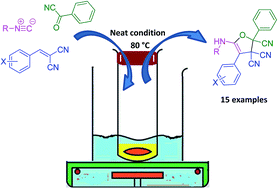Isocyanide-based three component reaction for synthesis of highly cyano substituted furan derivatives†
Abstract
A rapid and efficient solvent-free one-pot synthesis of novel alkyl amino aryl furan tricarbonitrile derivatives is described under catalyst-free conditions. This reaction was carried out through a three-component condensation reaction of isocyanides, 2-arylidenemalononitriles and benzoyl cyanide under solvent-free conditions. Neat conditions were established with many advantages, including high yield, environmentally friendliness, and easy and quick isolation of the products. The newly synthesized compounds were systematically characterized by IR, 1H NMR, 13C NMR and elemental analysis.


 Please wait while we load your content...
Please wait while we load your content...